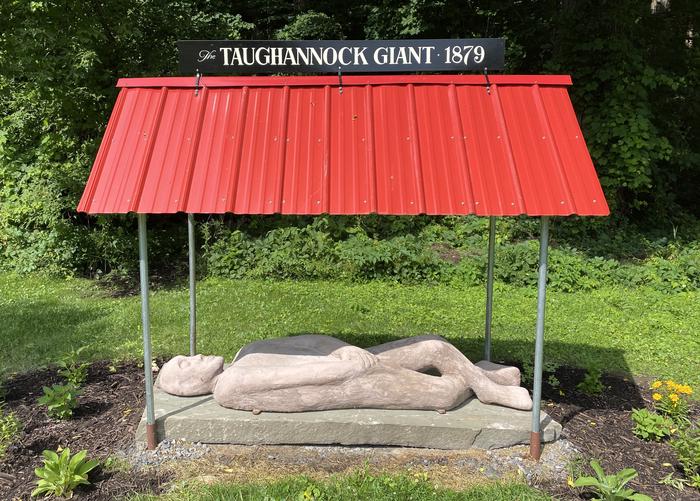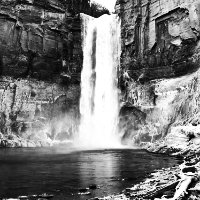Ithaca and Trumansburg
Trumansburg was first settled by Abner Tremaine (Tremain, Treman) in 1793 after he was given the land for his service in the Revolutionary War. Another soldier, Hermon Camp, settled in Trumansburg after the War of 1812, where he lived in a Greek Revival style house that still stands today on eponymous Camp Street. Throughout the 19th century, the population grew and farmland gave way to a residential community. Trumansburg was recorded as an official village in the town of Ulysses in 1872. Since then, as infrastructure continued to improve, Trumansburg became a popular bedroom to many professionals in Ithaca, including Cornell and Ithaca College. Notable Trumansburg residents include:
- Robert Arthur "Bob" Moog had a storefront on Main Street in Trumansburg. His analog music synthesizers became popular in the 1960s, and there's a historic marker on Main Street to commemorate Moog's storefront location.
- Dr. Hermann Biggs was born in Trumansburg. After graduating from Cornell, he became a public health pioneer in the field of antibacterial medicine.
Nearby Ithaca is the largest city in Tompkins County. Saponi and Tutelo Native Americans inhabited the area until 1779, when General John Sullivan's troops claimed the land for the United States. The land was divided up as payment to Revolutionary War veterans, who in turn started to farm the fertile land. In the early 1800s, roads and railroads connected the area to other towns big and small. Ezra Cornell, who founded Cornell University in 1868, funded much of the railroad infrastructure to help increase enrollment at the university.
Ithaca has a rich academic and artistic history, hosting engineers and professors at Cornell University and Ithaca College, and playing a pivotal role in the silent film era. Simeon DeWitt, the surveyor-general of New York, named Ithaca after the Greek island Ithaka. If you've read Homer's Odyssey, that's where Ulysses was born.
Indian Villages

Base trail plaque
You can find this plaque at the start of Taughannock's base trail.
Occupied by Taughannocks situated north and south of stream. Burial ground on bluff West of John Jones home site. Indians named lake Guenguch. First white settlement 1794 by two Goodwin brothers.
The Overlook
Taughannock Falls' overlook is one of the most visited sites in the Finger Lakes. If you've ever visited, you know why. It has a beautiful view of the gorge and waterfall. Today there's a visitor center and a parking lot amid the landscaping and curved pathways (all part of $1.9 million in upgrades in 2015), but there used to be a hotel on the site in the 1800s and early 1900s.
Tony Ingraham's (Owl Gorge Productions) video about the excavation and renovation is wonderfully detailed. Used here with permission.
J.S. Halsey built the Cataract Hotel at the overlook in 1850. Sixteen years later, it became known as The Taughannock House after renovations and expansion. Visitors arrived at The Taughannock House by train to either end of Cayuga Lake, and then a steamboat ride to Goodwin's Point (which we now know as Taughannock Point). A stagecoach ferried visitors up the hill to the hotel.
John M. Thompson purchased the hotel in 1872. During this time, several efforts to market the area are noteworthy:
- Professor Jenkins, a Canadian stuntman, crossed the gorge on a tightrope
- The Taughannock Man (Tauggy) was discovered in 1879 during hotel renovations and put on display (see below)
George Freer purchased the hotel in the 1890s, though business started to decline in 1905. Freer left the hotel ten years later and the hotel languished. Investors took over in 1922 with the goal of reinvigorating the property, but a chimney fire changed their plans, burning the hotel to the ground. Two years later, the overlook was purchased by the Finger Lakes State Park Commission.
Trumansburg's Taughannock Giant
The Taughannock Man (Tauggy) was discovered in 1879 during hotel renovations and put on display before it was revealed as a hoax. Ira Dean teamed up with John Thompson to create this stone giant using stone dust, eggs, minerals, iron fillings and beef blood. After its "discovery" Cornell scientists deemed the corpse authentic, lending credibility to the story and the draw for tourism to see the artifact.
In 2019, artist Annemarie Zwack, along with Durand Van Doren and Teo Aceto, created a replica of the Taughannock Giant. At July 3, 2021 at 11 a.m., the replica giant was placed in a small pavilion across from Trumansburg's Farmer's Market (map) on a slab of native stone (press release).

The Taughannock Giant, 1879
The Black Diamond
The Black Diamond Express started service on May 18, 1896. It was a fitting name for a train on a route conceived of to haul coal, but became popular by hosting luxury coaches to connect the area with Buffalo, Ithaca, Geneva and New York City.

Black Diamond Express
The Lehigh Valley's 315-foot long Black Diamond Express ferried passengers from New York City to Buffalo. The train was known for its speed and onboard dining. Passengers could sit in velvet chairs, mingle in a large well-appointed smoking room and avail themselves of gender-specific lavatories. The last car in the train included a parlor and observation platform, where passengers could look out plate glass windows at the passing landscape. The rails on which the train rode became known as The Route of the Black Diamond. Many newlyweds took this route to get to Niagara Falls, so the train was also known as the Honeymoon Express.
The cities of Ithaca and Geneva had busy passenger stations on this route, and both buildings are still around today. The Black Diamond trail, accessible from the western edge of the park, goes straight to Ithaca along the route of one of the original railroad beds.
Source: Lehigh Valley Railroad Historical Society, April 2013
Further Reading about the Black Diamond
- Lehigh Valley Railroad Historical Society
- Wikipedia
- American Rails: The Black Diamond
- Video of the Black Diamond Express
- Scot Lawrence's Black Diamond Express
Flooding
Weather can dramatically affect Taughannock Creek. In drier times, the falls can almost dry up, yet the creek can flood during massive snowmelt or heavy rains. The park does a wonderful job maintaining the trails and bridges amid these massive natural changes.
The summer of 1935 saw one of the greatest floods of the 20th century at Taughannock. In the late evening on July 7, heavy rains flooded the gorge enough to wash out a bridge and a park pavilion. A mill located more than a mile upstream was also a casualty, being swept down the creek and over Taughannock Falls.
Safety at Taughannock Falls
You'll notice that portions of the rim trail are fenced. At the end of the base trail there's also a clearly-marked stone wall that you shouldn't go beyond. This is for good reason, given the geology of the gorge and fragile nature of the walls. Over the years, Taughannock has seen tragedies, both intentional and not. Be safe when you visit!
Are you upset, confused, depressed, lonely, hurt, angry, scared, suicidal, worried about someone else, or so overwhelmed that you don’t know what to do? The Suicide Prevention and Crisis Service of Tompkins County Crisisline is available 24/7 at 607-272-1616 or 800-273-TALK (8325). Or, call 988 anytime for the Suicide & Crisis Lifeline.
- April 23, 2005 A woman was rescued after she fell 70 feet into Taughannock gorge.
- August 23, 2005 A 51-year-old New Jersey woman died after a rockslide fell on her *
- December 3, 2010 Tine Rubow Ph.D. ’10, a recent Cornell graduate, jumped to her death
- October 24, 2013 Brian K. Austin's body was found in a wooded area. He had been missing from the Syracuse area since 2011
- December 1, 2013 An older man's body was recovered from a creek at Taughannock
- July 31, 2015 A woman was rescued after she fell nearly 100 feet into the gorge. She died the next day from her injuries.
- August 18, 2017 Geoff Geppert died in an accident and was recovered about a half-mile down the gorge trail
- August 8, 2022 The body of a 39-year-old man from Johnson City was discovered in the gorge. A recovery operation was conducted from the south rim trail. Police determined that the cause of death was suicide.
- May 23, 2023, 14850.com Four visitors from Syracuse, aged 16 to 26 years old, went swimming beyond the ‘No Swimming’ sign at the base of the falls. They struggled in the cold water and Leo M. Nolasco-Cruz (26) disappeared beneath the water. His body was recovered by members of New York State Police’s Underwater Recovery Team. A 19 year-old in the group was airlifted to a Syracuse hospital for hypothermia and water ingestion.
- December 15, 2024 An unnamed person was found dead after being retrieved from a creek about a quarter-mile above Taughannock Falls. Local rescue crews, New York State Police and the State Park Police responded to a report of a person who fell into Taughannock Gorge at Taughannock Falls State Park shortly before midnight Sunday.
- February 4, 2025 New York State Police assisted Park Police in investigating a missing Cayuga Heights woman experiencing a mental health crisis. Troopers found her deceased in a creek near the Taughannock Falls State Park trail.
* In 2012, a court ruled the state of New York was not responsible because she was standing in an area clearly marked off limits by signage.
